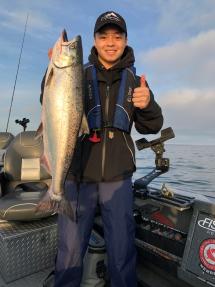What is the North of Falcon process?

Each year state, federal, and tribal fishery managers gather to plan the Northwest's recreational and commercial salmon fisheries. This pre-season planning process is generally known as the "North of Falcon" process, which involves a series of public meetings involving federal, state, tribal and industry representatives and other concerned citizens.
The North of Falcon planning process coincides with the March and April meetings of the Pacific Fishery Management Council (PMFC), the federal authority responsible for setting ocean salmon seasons 3 to 200 miles off the Pacific coast. In addition to the two PFMC meetings, the states of Washington and Oregon and the Treaty Tribes sponsor additional meetings to discuss alternative fishing seasons that meet conservation and allocation objectives. Fishery managers generally refer to the entire set of pre-season meetings as North of Falcon. The name refers to Cape Falcon in northern Oregon, which marks the southern border of active management for Washington salmon stocks. See our North of Falcon timeline (PDF) for more information. Also see our WDFW North of Falcon FAQs and Glossary Information (PDF) for key terms and suggested resources.
What is the first step in the North of Falcon process?
The North of Falcon process starts in late February/early March when the run-size forecasts are first available. Wild and hatchery run sizes for all salmon species from various areas of the state are considered in planning fisheries for the upcoming season. Expected Alaska and Canadian harvest levels are also considered, as fishery managers and the public consider the seasons that will meet conservation goals for all salmon stocks.
What happens at the March and April council meetings?
At the March PFMC meeting, preliminary decisions are made about possible ocean fishing seasons. During the April PFMC meeting, the council finalizes recommendations to the Secretary of Commerce regarding ocean commercial troll and recreational fishing seasons and catch limits off the coasts of Washington, Oregon and California. Public testimony is received at both of these council meetings as well as hearings scheduled between the two meetings.
Find meeting summaries and additional information at our Salmon Daily Digest blog, our regular updates on the salmon fishing season setting process.
What happens at the North of Falcon meetings?
The two North of Falcon meetings are an opportunity for discussion, analysis and negotiation among all interested parties. Participants investigate the biological consequences of options for the outside (ocean) and inside (Puget Sound, coastal, and Columbia River) fisheries and try to achieve a consensus on an overall management plan for the upcoming fishing year. The process is supported by technical analyses provided by professional biologists from various state, tribal and federal management agencies.
In between the two North of Falcon meetings there are several other public meetings in March and April to discuss regional fisheries issues. Find meeting summaries and additional information at our Salmon Daily Digest blog, our regular updates on the salmon fishing season setting process.
What does the final management plan look like?
There are several pieces to the final pre-season plan. Besides the PFMC recommendations for the ocean fisheries, the State of Washington and the Treaty Tribes develop written agreements governing various terminal areas (e.g. Grays Harbor, Skagit River). After the April PFMC meeting, the Washington Department of Fish and Wildlife adopts recreational and commercial fishing regulations. Recreational fishing regulations are published in a sportfishing pamphlet, and commercial regulations are sent to all licensed commercial fishers, buyers and industry representative organizations.